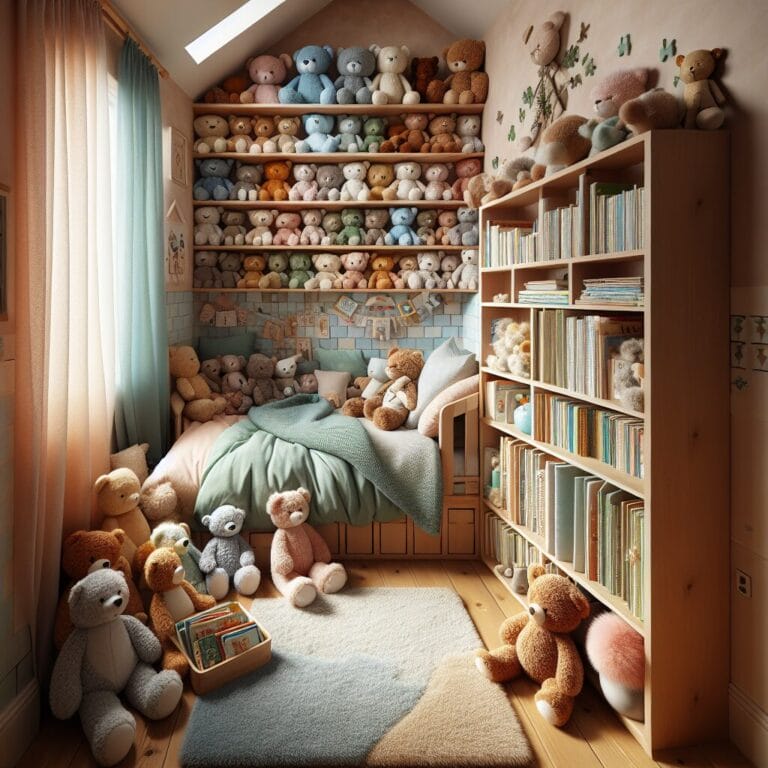
10 Sleep Optimization Tips for Toddlers in a Screen-Heavy World
Table of Contents
- Introduction
- Understanding Sleep Needs
- The Screen Time Dilemma
- Tip 1: Establish a Consistent Sleep Routine
- Tip 2: Create a Sleep-Conducive Environment
- Tip 3: Limit Screen Time Before Bed
- Tip 4: Encourage Daytime Physical Activity
- Tip 5: Monitor Content Consumption
- Tip 6: Use Blue Light Filters
- Tip 7: Promote Relaxation Techniques
- Tip 8: Be Mindful of Napping
- Tip 9: Educate on Screen Use
- Tip 10: Lead by Example
- Conclusion
- Frequently Asked Questions
Introduction
Hey there, all you super moms and dads! Let’s chat about something mega-important for our little ones: getting enough Zzzs in this gadget-filled world. So, did you know that those shiny screens can sneakily mess up your tiny tot’s sleepy time? Yup, too much screen time before beddy-bye can lead to fewer winks. Now, we’re not saying screens are the big bad wolf; they’ve got their perks for sure. But when it’s time to tuck in, let’s make sure gadgets aren’t invited to the pajama party.
Here’s a cool tip—why not swap out game consoles with storybooks or playtime that gets their little legs moving? This switcheroo could be just the ticket to dreamland. And oh boy, setting up a bedtime routine is like having a secret code for “it’s snooze o’clock.” Keep it consistent and cozy—the kiddos will love knowing what’s next!
Plus, decking out your child’s bedroom as a sleep haven works wonders. Think soothing colors, comfy blankets, and yes—those glowing alarm clocks and flashy lights gotta go (sorry, nightlight!). We want those sweet dreams on autopilot!
And remember how awesome physical activity is during the day? It not only keeps them chipper but helps them conk out faster at night. So let ’em run wild—at the park though, not after bedtime! Lastly, keeping an eye on their overall sleep profile can clue you in if something’s off. Not enough Zzzs could mean cranky pants mode ON.
Alrighty, keep these nuggets in mind and you’ll be on track for gifting your munchkin the best gift ever—a good night’s sleep! 🌙✨

Understanding Sleep Needs
Ever wondered what’s the secret sauce for your munchkin’s brain boosting and growing muscles? It’s a good night’s sleep! But wait, did you know those sneaky screens can be sleep-stealers for our tots? Here’s the scoop: Health experts from the American Academy of Pediatrics (AAP) warn that infants younger than 18 months should steer clear of screen media, except maybe some video-chatting with granny. For older toddlers and school-aged children, it’s all about balance—enough play during the day but winding down at night.
Now picture this: A quiet, cozy childs bedroom with no blue-light beamers like tablets or glowing alarm clocks flashing lights—it sets just the right mood for a peaceful doze-off. And hey, a consistent bedtime routine is like a magic spell for sleepyheads; think cuddles and storytime instead of cartoons and game consoles. Why not sprinkle in some daytime frolic to tire them out? Physical activity is pure gold for tiring out those energizer bunnies!
Skimping on shut-eye can mean trouble sleeping later on and even mess with how well kids learn and play. Plus, their mental health takes a hit too without enough Zzzs—it’s more frowns than giggles if they don’t sleep enough. So let’s make sure we’re mixing up healthy sleep habits like proper sleep duration, dimming those screens early, and setting kiddo-friendly rhythms that encourage good sleep habits from dusk till dawn!
The Screen Time Dilemma
Let’s zoom into the blue light buzz—those little beams from screens can be big-time sleep disruptors for kiddos. When the sun dips down, our bodies get ready for nighty-night time by making a snooze-juice called melatonin. But here’s the kicker: that same blue glow from tablets and phones tells their tiny bodies, “Hold up, it’s still playtime!” and whoops, there goes the sandman.
The Pediatrics AAP is all over this, flagging how crucial it is to dial down on digital media as stars twinkle. For little tykes and school-aged dynamos alike, they say keep screen habits neat—more books and blocks, less peepers on pixels before bed. And get this: physical activity isn’t just awesome sauce for day adventures; it helps ensure your nugget hits the hay faster when bedtime rolls around.
Maybe you’re thinking, “But wait! My tot’s room has more LEDs than a Christmas tree!” No sweat—ease up on those glowing gadgets as you sprinkle in healthy sleep vibes. Because here’s the deal: A proper sleep profile ain’t just about clocking hours; it’s about quality zzzs in a haven of calm. So let’s craft bedtime routines that whisper “sweet dreams” minus digital screams, shaping a future where infants children adolescents alike can ride the slumber express right through dreamland station.
| Aspect | Impact on Sleep | Recommendations |
|---|---|---|
| Blue Light Exposure | Disrupts melatonin production, leading to difficulty in falling asleep | Minimize screen time before bedtime |
| Screen Habits | Increased alertness and engagement, making it harder to wind down | Encourage quiet activities like reading or playing with blocks |
| Physical Activity | Helps with faster and more restful sleep | Incorporate physical play during the day, but not too close to bedtime |
| Bedroom Environment | LEDs and bright lights can keep the brain alert | Reduce the number of electronic devices with LEDs in the bedroom |
| Sleep Quality | Integral for overall health and well-being | Create a calm sleeping environment, establish a soothing bedtime routine |
Tip 1: Establish a Consistent Sleep Routine
Did you know that a predictable sleep schedule isn’t just about avoiding meltdowns? It’s actually key to helping your kiddo thrive! When little ones know what’s coming next, their tiny internal clocks start to align with the world around them. This means better, more restful nights and happier days filled with giggles instead of yawns. Imagine turning their childs bedroom into a sleepytime sanctuary where good nights sleep is just a fluffy pillow away.
Here’s how you can up your bedtime game: Start winding down earlier than you think necessary. Young children love routines, so why not introduce calming activities like a warm bath or some gentle stretches? And when it comes to storytelling, let those adorable plushies join in for an epic adventure in dreamland. But remember, as the clock ticks closer to bedtime, dim the lights and dial back on noisy toys; keep those glowing alarm clocks and flashing lights out of sight.
Encouraging good sleep habits goes beyond setting a strict lights-out time. Keep screens off the agenda at least an hour before bed—yep, that includes TV time. Instead, fill this hour with soothing music or whispers of tomorrow’s fun plans. By fostering these healthy sleep habits consistently, you’re building a solid foundation for your child’s development. And hey, don’t discount those daytime dashes and jumps; physical activity is crucial for burning off excess energy!
Crafting a sleep-friendly routine needn’t be daunting—it’s about repetition and cues that signal “Time to get cozy!” So give those cuddly bedtimes stories center stage over game consoles and create memories each night while steering clear of the post-dinner screen craze. After all, every parent dreams of gifting their child with peaceful slumber in an ocean of dreams.
Tip 2: Create a Sleep-Conducive Environment
In the digital age, a toddler’s bedroom has to be more than just cute; it needs to be a cocoon where dreams are brewed and rest is undisturbed. Think of it as a sleep lab, where every element is carefully chosen for its magical sleep-inducing powers. Ditching those glowing alarm clocks and flashy lights plays a crucial part in this setup. Instead, imagine walls painted in calming hues, snuggly blankets that whisper “sleep tight,” and books that promise adventures in slumberland.
But here’s an insider secret: Encouraging good sleep habits isn’t just about the décor—it’s about setting up a sanctuary free from digital buzzes and beeps. Reducing screen media exposure, particularly before bedtime, can ward off trouble sleeping caused by overstimulated brains. To build these healthy sleep habits, weave physical activity into your child’s day to help them burn energy, paving the way for restful nights. This strategy not only safeguards your child’s mental health but also fortifies their developing bodies against the repercussions of insufficient sleep.
Finally, let’s touch on something surprisingly simple yet strikingly effective—conversation! Chat with your young children about why we snooze at night and how cool darkness actually helps us drift off faster. By doing so, you’re not only nurturing their curiosity but also reinforcing healthy attitudes towards getting enough shuteye. Remember, whether you’re dealing with infants or adolescents, joint efforts between daytime playtime, mindful screen habits and a serene childs bedroom will champion the cause for sweet dreams amidst our pixel-filled reality.
Tip 3: Limit Screen Time Before Bed
As the stars begin their nightly twinkle, it’s paramount for tiny tots to unplug from the digital world, making way for a journey to dreamland. The Pediatrics AAP advises that at least an hour before bedtime is the golden gap for young children and school-aged rascals alike to bid farewell to screen time. This pause from pixels helps signal to their bodies that it’s almost time to hit the hay, ensuring their sleep duration isn’t cut short by the stimulating effects of digital media.
Now let’s get creative with screen-free wind-downs! How about a treasure hunt where pajamas are the prize or a mini bedtime Olympics with pillow jumping (soft landing guaranteed)? For those little artists, drawing out their dreams can be both calming and exciting. And don’t forget those old-school classics like building forts from blankets—perfect havens for storytelling. These activities not only encourage good sleep habits but also foster a bond between parent and child, crucial for healthy mental health development.
It’s clear that setting up a robust bedtime routine without screens plants the seeds for flourishing sleep profiles in infants, children, adolescents—the whole gang! So why not transform those pre-slumber hours into a festival of imagination? Doing so nurtures kids’ curiosity while safeguarding them against the pitfalls of insufficient sleep in this high-tech era.
Tip 4: Encourage Daytime Physical Activity
Did you know that the very playgrounds and parks your toddlers love are secret allies in the battle for better bedtime? It’s not just about wearing them out—it’s science. Engaging in physical activity boosts natural sleep hormones, making drifting off as easy as counting sheep. Let’s turn those energetic playtimes into a gateway for golden slumber.
Picture this: instead of screen time, your little one is giggling on swings, mastering the art of hide-and-seek, or even doing a wiggle-filled dance routine right in your living room. These joyful jaunts aren’t just fun; they’re laying down the tracks for healthy sleep habits. Every hop, skip, and jump during the day is like investing in a bank of sleepytime gold coins.
And here’s another tip straight from the sleep fairies—craft an ‘Energy Hour’ packed with lively games like Simon Says or Freeze Dance. Even mundane chores can become part of their exciting pre-bedtime movement marathon—picking up toys becomes a pretend lava-floor adventure! When these activities replace game consoles and glowing screens pre-slumber, young children are more likely to nod off quicker come bedtime.
By fostering these dynamic daytime routines, you’re doing double duty: encouraging good sleep habits while also contributing positively to your child’s development. So let the digital media take a back seat and watch as your toddler’s sleep duration—and quality—goes from strength to dreamy strength.
Tip 5: Monitor Content Consumption
In a world where each tap on a screen can lead to a rabbit hole of endless content, it’s crucial we guide our tiny tech-users with wisdom. Setting boundaries around screen time isn’t just about being the ‘fun police’; it’s about fostering an environment where your child’s sleep and overall development are put first. As you craft a bedtime routine that sings lullabies, not jingles, consider introducing parental controls as trusty sidekicks in safeguarding your child’s digital journey.
Navigating the landscape of infants children adolescents’ health safety online requires you to be as nimble as they are curious—this is where an online health information resource becomes your ally. Establishing reasonable screen habits tailored to their age ensures that while they’re learning from educational apps during the day, their nights remain sacred for rejuvenation. The Pediatrics AAP reminds us that consistent bedtime rituals paired with proper sleep durations lay down roots for physical and mental health prosperity that bloom well beyond childhood.
Envision this: In place of glowing screens casting shadows in your child’s bedroom, night falls with soft whispers of storybook fantasies. Balance is key—where game consoles carve out time for park playscapes and hide-and-seek champions take center stage over social feeds and video streams. By adopting these healthy screen limits, coupled with active daytime adventures, you’re not only encouraging good sleep habits but also anchoring a lifestyle that values rest as much as play for every young explorer journeying through growth milestones.
Tip 6: Use Blue Light Filters
Did you know that the blue light from our countless devices can trick toddler brains into thinking it’s daytime? It’s true! That pesky light messes with their natural sleep-wake cycle, making bedtime seem like a faraway land. But fear not, tech-savvy parents, because there are nifty solutions to shield those little peepers and ensure your child’s sleep is as sweet as their giggles.
Enter the world of blue light filters—these handy tools can be the knights in shining armor for your young one’s sleep routine. By tweaking the color temperature on tablets and smartphones, or by adding physical screen protectors that block blue hues, you’ll help set the mood for dreamland right at sunset. And let’s not forget about cozying up their bedrooms; they’re castles where dreams come alive, after all. A soothing ambiance with warm lights and perhaps a star projector can transform their personal space into a snug retreat away from digital buzz.
As we juggle encouraging physical activity during daylight hours and cultivating solid screen habits, it becomes clear how intertwined these elements are to nurturing healthier sleep profiles. The Pediatrics AAP stresses balance when it comes to screen media use—a harmony that reverberates through every aspect of our toddlers’ lives.
So let’s rally behind making bedtime routines as pure as storybook tales, sans screens. After all, nurturing good nights sleep patterns today leads to flourishing health safety outcomes tomorrow—both online and offline—for our young adventurers navigating growth milestones under starlit skies.
Tip 7: Promote Relaxation Techniques
As twilight paints the sky with its dusky hues, the age-old tradition of guiding little ones to the land of nod gets a modern-day remix. Forget game consoles and buzzing screens; it’s time for parents to become the maestros of mellow with sleep-friendly relaxation techniques that are just right for their toddlers. Picture this: a quiet room where soft fabrics meet cuddly toys, all awaiting a gentle storytime session led by mom or dad’s soothing voice—this is where sweet slumbers begin.
Creating moments filled with calm breaths and simple yoga poses designed for tiny bodies can work wonders, turning pre-bedtime jitters into serene readiness for sleep. Engage young children in shadow puppet plays against a wall bathed in warm light, encouraging creativity while slowly nudging them toward dreamland. The Pediatrics AAP would nod in approval, knowing such screen-free activities contribute to a healthy sleep schedule and overall mental health.
But here’s something even cooler: How about personalized lullabies? Tailor-made tunes that whisper your child’s name as they drift away under a blanket of stars projected on their ceiling—it’s like crafting a mystical voyage tailored just for them. Not only do these practices encourage good sleep habits among infants children adolescents alike, but they also foster an intimate bond between parent and child—a key ingredient in the recipe for restful nights and energized mornings. So let’s embrace our role as guardians of tranquility, ensuring our little ones’ sleep profiles are as beautifully crafted as their dreams.
Tip 8: Be Mindful of Napping
Imagine the bustling energy of a toddler as they zip and zoom through their day, brimming with boundless curiosity and joy. It’s this very exuberance that we, as caregivers, gently guide towards calmness as the sun sets, cultivating an oasis of rest even in our screen-saturated age. While naps are like little recharging stations for these pint-sized explorers, striking the right balance between daytime dozes and nocturnal slumber can be key to preventing unintended midnight parties in the crib.
Monitoring signs of excess daytime sleepiness—such as crankiness or frequent yawning—can signal it’s time to tweak those nap schedules. Perhaps it’s shortening afternoon siestas or nudging them earlier; each child’s sleep profile is unique as their favorite stuffed animal. By harmonizing their midday zzzs with a consistent bedtime routine free from the digital media’s hustle and bustle, young children stand a better chance at achieving that coveted good night’s sleep.
So let’s embrace natural rhythms; ensuring game consoles power down well before stars twinkle high helps safeguard precious dreamtime from glowing screens’ intrusive glare. And when those eyelids flutter shut without protest, we’ll know we’ve struck gold—a perfect alchemy between healthy sleep habits and tailored daily activities that nourish both mind and body for the vibrant journey of childs development.
Tip 9: Educate on Screen Use
In a world awash with beeping gadgets and flashy tablets, teaching toddlers about the sacred bounds of screen time is akin to guiding young navigators through a digital sea. It’s essential to involve these sprouting minds in setting their own screen boundaries, cultivating a sense of responsibility that blooms alongside their understanding of technology. Consider this: as you lay down the law on tech usage, have your little one chime in with their thoughts. Might they opt for an episode of their favorite cartoon over game consoles? Or perhaps exchange some tablet tapping for extra storytelling under the stars?
Ingraining this autonomy not only polishes their decision-making skills but also embeds healthy sleep habits deep within their routine. With the Pediatrics AAP advocating vigilant parenting in digital media consumption, it becomes our quest to ensure our tiny tots’ screen habits align seamlessly with their need for wholesome sleep—a cornerstone for robust childs development.
Here’s a fun spin—transform the task of managing screen time into gamified choices: “Do we want to play with our blocks tonight or watch a show?” This gently steers them towards physical activity—a proven ally against insufficient sleep—and away from the blue light’s lullaby. By doing so, we’re not just sculpting sleep-friendly environments in our young children’s bedrooms; we’re instilling lifelong skills to tackle the ever-growing wave of digital distractions. Mark each day as an opportunity to underline the importance of good night’s sleep and safeguard those innocent eyes from too much glow before bed, ensuring that when heads hit pillows, dreams are ready for takeoff.

Tip 10: Lead by Example
In our buzzing digital era, setting the scene for serene slumber starts with us—the grown-ups. Just as little ducklings follow their mother’s waddle, our toddlers often mirror our screen habits. It’s not enough to tweak the nightlights or fluff up the pillows in your child’s bedroom; a crucial part of encouraging good sleep habits is reflecting on our own use of gadgets. If we’re scrolling at supper or texting at twilight, aren’t we penning an unwritten bedtime story that says screens are sleep’s sidekick? Let’s flip the script and craft a family culture where devices snooze well before we do.
Here’s how we can make it happen: Hold a family pow-wow and brainstorm fun, screen-free ways to unwind together after dinner—maybe it’s a goofy dance-off or creating epic tales with shadow puppets against the walls of your child’s bedroom. By swapping game consoles for giggle-fests and making physical activity like tag or hide-and-seek a post-meal must-do, you’ll not only bolster those sleepy-time hormones but also bond over belly laughs.
And here comes the kicker—weave these playful pastimes into a consistent bedtime ritual that doesn’t just signal “time to sleep” but also “time to connect.” Combine this with clear rules about when screens go dark, and you establish an environment ripe for restful nights. The Pediatrics AAP suggests that healthy screen time management is pivotal not just for young children but across all ages—infants, children, adolescents—and we have the power to shape these guidelines within our homes.
By modeling mindful screen use ourselves and celebrating bedtime as quality time rather than a hurdle before hitting play on our favorite show, we create a shared understanding of health safety in both the real and online worlds. So let’s lead by example and infuse our family ethos with habits that honor both tech’s place in our lives and the timeless value of sweet dreams under starlit skies.
Conclusion
Hey, amazing parents! Did you know that while we tuck our tots in for the night, their sleep patterns are dancing a delicate ballet with digital distractions? When it comes to optimizing toddler sleep in the digital age, consider the ambiance of your child’s bedroom—transform it into a peaceful nighttime nest. Dim those lights, embrace soft lullabies over loud TV shows, and maybe introduce a snuggly bedtime buddy who’s all about Zzzs. It’s not just about less screen time; it’s about crafting moments that gently guide young children towards a sky full of sweet dreams without unnecessary wake-ups caused by glaring screens or untimely tech-related noises.
Let’s sprinkle in some fun – think pillow forts and shadow stories to ignite their little imaginations while winding down. And don’t let the day slip away without bundles of active play; physical activity is the secret ingredient for a hearty sleep recipe. Pediatricians stand by this, knowing that toddlers’ brains grow best when nights are filled with quality slumber. So push past those tempting glowing alarm clocks flashing lights and game consoles at sundown; instead, weave a consistent bedtime rich with tales and cuddles that leave infants, children, and adolescents ready to drift off into dreamland.
Remember, establishing these healthy sleep habits takes teamwork—a duet between dedicated guardians and their wee dreamers. Hang in there as you navigate through school-aged children’s love for screens and maintain an iron-clad sleep routine—it’ll pay off with every giggle-filled morning after proper sleep!



